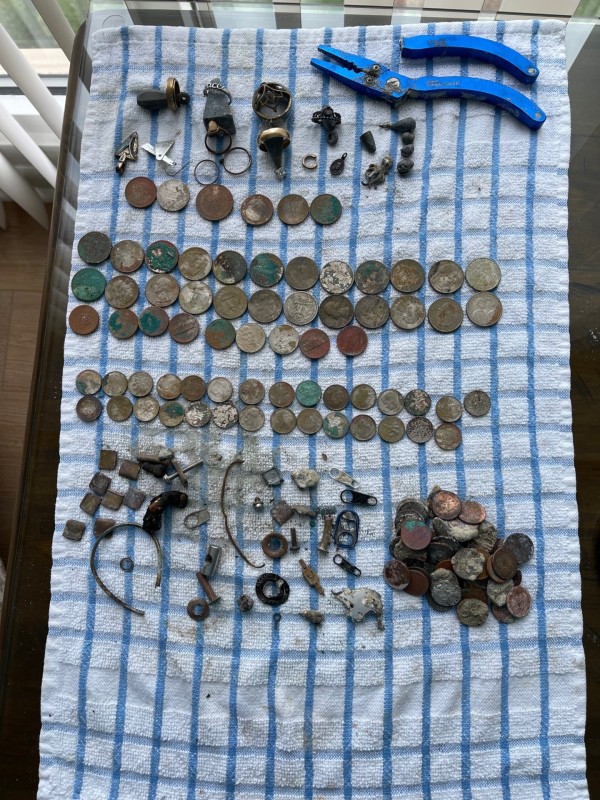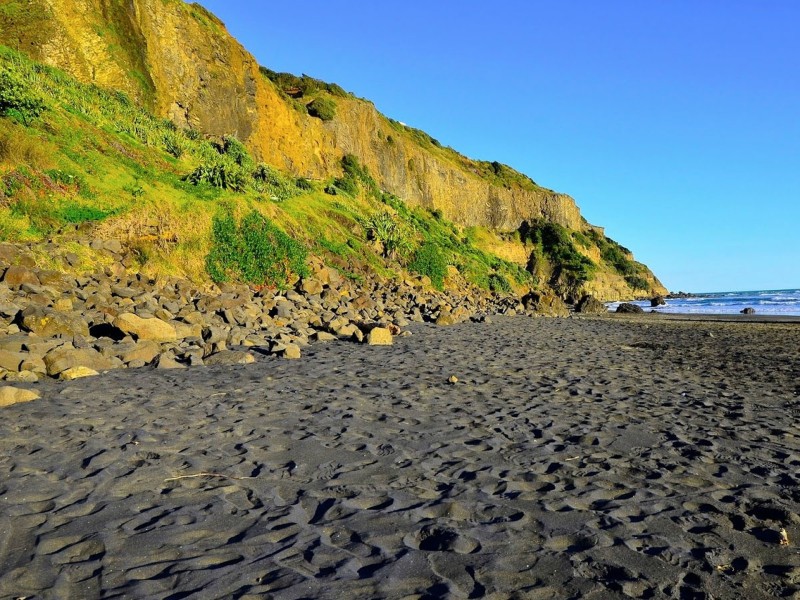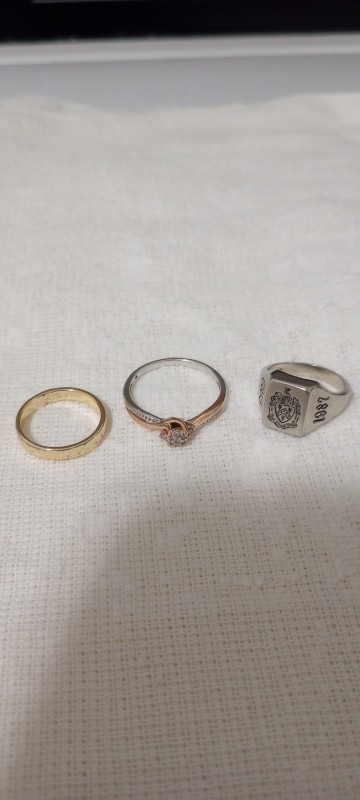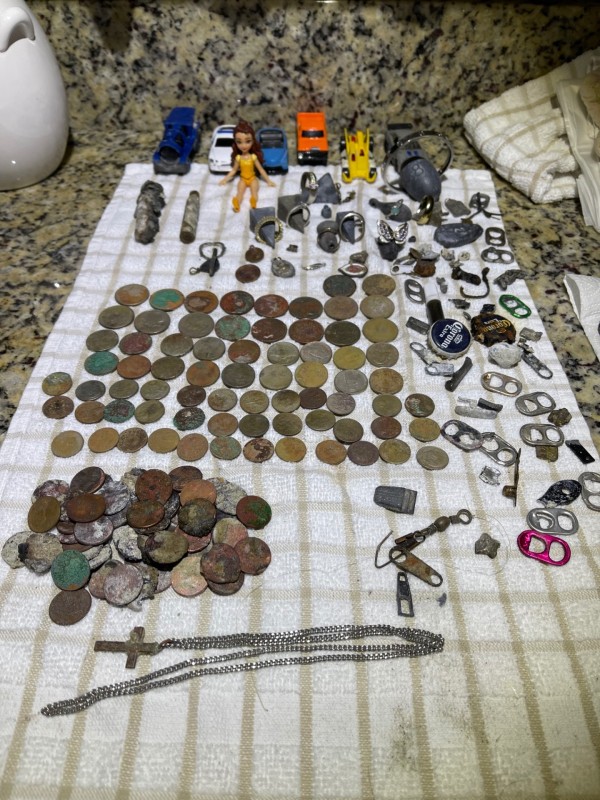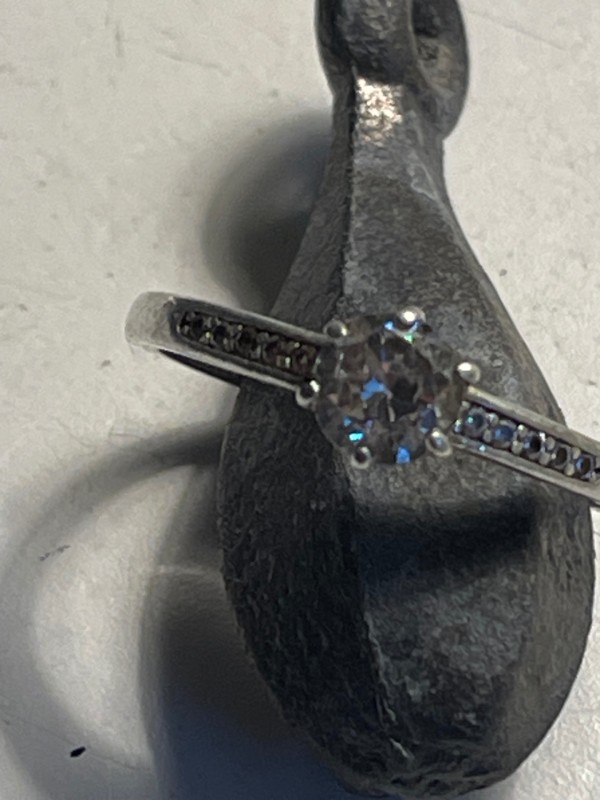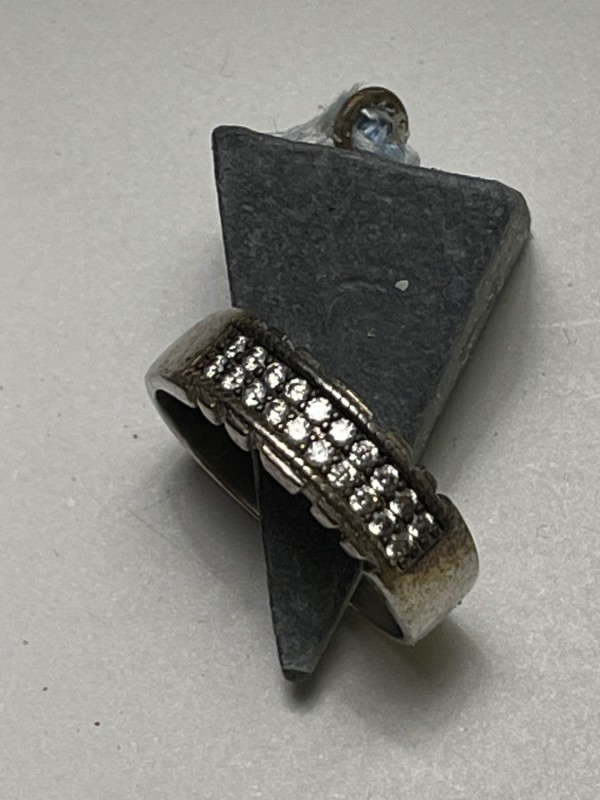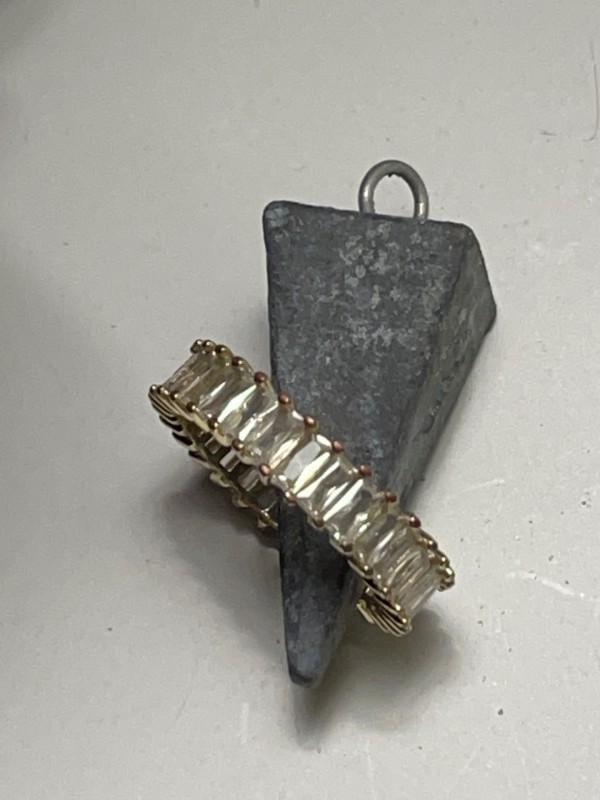Search the Community
Showing results for 'Tarsacci'.
-
CalReg Thanks for your reply. Looking over what comes with the Tarsacci and I hope I miss read that it only comes with one battery now. I know on my other Tarsacci I did get two batteries and you’re still having to pay shipping. Some of the cheapest detectors I’ve bought they came with free shipping. I think a lot more Tarsacci would be sold if nothing else change the shade of red on the control buttons. What can I say other than I wasn’t happy with myself when I sold my first one. In my opinion the stock coil is better than the bigger one but that’s just me. Chuck
-
I have neither seen nor heard of any Tarsacci updates. To be honest, I quit looking for them as they became scarce a few years after they were released. With that said, I decided to hunt a beach recently, and I will tell you, it is still the quietest (single or multi-frequency) detector I have ever used. Black sand does NOTHING to this thing! It is deep too! While I didn't find anything of significance. I found a handful of items that were at least a foot deep! Hunting in all metal gives me the best results, but I'm getting to an age where I just don't want to dig everything, so I switch to discrimination mode. I might lose some depth, but the hunt is more enjoyable...good luck on your search!
-
Thanks for the detailed and well thought out response Hugh (and others). I will point out for the record though that gold is just another non-ferrous metal, not magical. Think $1 gold coin instead of gold nugget. From a straight up number of targets under coil a 5x8 coil should be superior to a 9" round coil from an electromagnetic perspective. My expectation would be that a 5x8 coil would have the edge over a 9" round coil finding a $1 gold coin in a nail pit. What you guys seem to be saying is you think that the Deus 2 processing and audio is superior to the Manticores to the point of negating the inherent edge a smaller coil size has. In a nail pit depth is not the issue - it is all about separation. For those that are unaware as mineral concentrations become intense the depth advantages normally conferred on larger coils not only are negated but actually can be reversed. Everyone always assumes that larger coils always go deeper and I can promise you that with any VLF that is not the case in my ground. I'm talking ground where PI detectors struggle. A larger VLF coil can go into overload and stop actually detecting. You know that ability of the Equinox in Beach Mode to automatically lower transmit power to deal with extreme magnetite? That was me. That said, Condor and I have observed that the Deus 2 has exceptional extreme ground handling capability that combined with the 9" coil makes it a formidable option compared to a PI detector in bad ground. Similar to what the Tarsacci was touted as having but in a much more useable package. So yeah Hugh while I am more comfortable with Minelab the fact is I may have to be an old dog learning new XP tricks. I am at a point where I want to pick one machine and be as expert as I can be with it as opposed to bouncing between two. Still looking to hit that magic combination of one good VLF and one good PI and being done with the new detector merry go round. That decades long goal of mine is well within reach now due to the latest options we have.
-

Has Anyone Used The Nexus Mp V3c For Nugget Hunting?
Steve Herschbach replied to jawbone's topic in Detector Prospector Forum
Exactly what Tarsacci claims. -
Should I Get Started With This Hobby?
CalReg replied to streak's topic in Metal Detector Advice & Comparisons
i split my time between local beaches and parks. If beach detecting is your gig. I'd lean towards a SMF (simultaneous multi-frequency) metal detector. You mentioned the Deus II, but there's also the Minelab machines (Equinox, Vanquish & Manticore) and the Nokta Makro line. Minelab, Deus and Nokta Makro dominate the market for SMF machines, but are not the only ones. Single frequency detectors can be noisy and inconsistent on the wet sand, but some (like my Tarsacci) will work. Do your homework. The next most important tool would be your scoop. Don't skimp here. Get a strong (but lightweight) scoop. Xtreme, and T-Rex are some of the most mentioned names, but there are more. Carbon fiber shafts lighten the load-if you can afford it. As far as pin pointers are concerned, I don't use 'em at the beach (I just move the sand around with my foot until I isolate the target), but I know some that do. Finally, you should buy a finds pouch. I use a waist belt pouch that is big enough for trash and treasure. Good luck! -
Just tested 8 gold rings, from a small thin 10k band to a very large class ring and everything in between. The Deus 2 had a spread of 48 on the lowest to an 88 for the class ring. For what it's worth, the Tarsacci had a spread of 5 to 17 for the same gold ring collection. I think this just goes to show how difficult it is to cherry pick with any detector, but I agree the Deus 2 is the hardest to cherry pick gold because of the huge numerical spread that it presents as gold.
- 31 replies
-
- problems
- jewelry detecting
-
(and 1 more)
Tagged with:
-

Welcome To The New AlgoForce Forum!
Steve Herschbach replied to Lead Detector's topic in AlgoForce Metal Detectors
No it is not hard to track them. They are all tagged, all you have to do is click the tag and you get them all. This is nothing more than new detector excitement and only a handful of threads. I only create new forums in response to sustained interest and having at least 30 threads, which is just enough to fill one page of a subforum. In the long run it takes more than one model, as the Tarsacci forum died out after nine pages due to no new releases. Long story short I am more than happy to start new forums but we are not anywhere near that yet. The main thing needed will be a lot more people here who actually own one. -
Hello everyone, I'm working on an interview/Q&A session with Dimitar Gargov for my site www.detectorstuff.com. Dimitar agreed to allow me to reach out to this forum and NASA Tom's to see if any of you folks may have a question or two. I'll try to include as many as possible! I also want to thank Steve H. for letting me ask here!
-
Ya I've got one beach that I've been to that I can't use any of my current detectors at because of mineralization. I brought my nox 600 there and I would get constant chatter that I thought was emi (maybe it is!). So when I got the manticore I brought it to this same beach and the manticore was quiet but I didn't find anything there. I finally did a similar test to your's and I could detect a quarter on the surface but as soon I covered it with sand it was gone. You would never know the beach was highly mineralized because the manticore lacks a mineralization meter. I need to get a pulse machine or maybe a tarsacci just to be able to detect this beach.
-
Two day s in on a new South Carolina beach. Totals so far Pennies: 42 Nickels: 9 Dimes: 29 Quarters: 24 Foreign: 6 Sinkers: 9 Rings: 7 Earring: 4 Pendants: 3 Weird Stuff: A lot I will post a final tally. Bill
-
-
Broken original post - content moved to first post in this thread.
-
I am spending a week at the beach waiting for the tide to go down. I will post the finds later. While reading the other posts about what is the best detector, I realized why the Tarsacci is the beach machine for me. 1. In mixed mode it gives a very clear dig or don't dig signal. Since I am a simple person, this is all I need. It doesn't matter if it's a penny or a gold ring, if the Tarsacci tells me to dig, I dig. 2. It will reach down 16 inches. In the surf, where the holes are filling in as quickly as I can dig them, I really don't need anything much deeper. Could I use it in the wet sand? Maybe, but how much deeper are the new machines? A half an inch? 3 It is built like a tank. I am pretty rough on my equipment and the Tarsacci has never failed me. 4. It pinpoints spot on when you find a target. The thing I hated about the Nox was the pinpoint function was poor and I would lose targets in the wet sand when they sunk out of sight because I was digging in the wrong place and the hole was filling in. Depth, Accuracy and Rugged. My only complaint is I would like it to be a little lighter, but Dimitar can do that with the next Tarsacci. Some people want accurate vdi numbers and pretty tones. I just want the machine to tell me when and where to dig.
-
Here is part 2 from the original interview Keith and I did w Dimitar. Part 1 Here Aaron. In part 1, we discussed how Dimatar got into metal detecting and designing detectors, his origins with Fisher, and the Tarsacci’s Salinity and Ground Balance features. In part 2, we talk more about the Tarsacci’s unique MDT technology. However as you’ll see, just like any other inventor, Dimitar is very cautious when discussing his “intellectual property”, and is one hard “egg” to crack! Aaron - Okay, so how about we talk a little about the “roots of the technology” of Tarsacci? Dimatar - Well, the “roots of the technology” is a on going problem and not related to Fisher or any other companies cause, its different. And this is why it is in Patent Pending, the patents are applied, and I’m just waiting when their released. The patents are applied here in the US and in Europe. Aaron - You’ve applied for International Patents? Man,,that’s EXPENSIVE! Dimatar - But, I have too! Because if you don’t do that, and you don’t invest in that direction, sure were talking about high expenses, but this also has to be added into the unit cost. Keith - Yes! Dimatar- And somehow, I need to get a reimbursement for my investment. But, it’s a hobby and I enjoy it and when this will happen, I do not know....Ha! But, I’m enjoying detecting, I enjoy designing metal detectors, I enjoy solving this challenges. Aaron - It’s very unique to find a metal detecting engineer who ALSO enjoys detecting, you know? Keith - Yes that’s rare, that’s REALLY rare! Dimatar - And...I’m LISTENING to the community! I detect for myself and every one of us has a different style, EVERYONE. Theres no universal recipe, you can give guidance, but to give magic settings to cover every place, such a thing does not exist. This is why I always advise the customers, you have initial settings which will help you to start. Once you understand the machine, start learning and listening to it, you’ll find your own way of detecting. Aaron - Yes, agreed. Keith and I were just discussing something very similar, in regards to learning the Tarsacci. Before I sent him the unit I told him: “Now listen, when I first started using this machine, I really didn’t like it! It’s totally different than anything I’ve ever used. I took me 30-40 hours until I REALLY started to enjoy using it! But, since your a better hunter than me you’ll probably figure it out A LOT sooner.” Then today, Keith tells me: “Yeah, you know what?I didn’t start figuring out what was going on with that machine until about a good 40 hours! Dimatar - HA! HA! Keith - Well that’s cause the audio is so much different than what I’m used too! It has a compressed audio.... Dimatar- Yeah! Keith - But if you listen inside that compression, THERE’S A LOT GOING ON. Dimatar - Speaking about that compression... Keith - Theres A LOT of “resonase” goin on in that BEEP. Dimatar - That’s correct, and there’s a reason for that! Let’s say, uh, a lot of times people ask: “how do you set up your threshold”? In the old days, when you had the pure analog technology, you always set up your threshold to the sound level. In this way you start to hear the very weak signals, and it’s up to the operator to decide, hmmm...is that a signal is that a noise or whatever. And a lot of times...you just guess. And at the same time, when you have a very shallow target, because of that, the sound level is very high, and it blows your ears. This is why I started thinking, well it doesn’t matter if you have a shallow target or a deep target, you have to be able to hear both targets, with a reasonable, comfortable sound level. And this is why I compressed the sound, for that reason. And this not by accident, it’s for a purpose. Keith - Yeah, i see it now, and it makes sense. And, to be honest with you, when I first ran it, I thought: “man, Dimatar don’t know what he’s doin!” Dimatar & Aaron- HAHAHAHAHAHAHA! Aaron - Same with me, I felt EXACTLY the same way! I said to myself what in the world is going on with these sounds and I can’t believe I bought this thing! Dimatar & Keith - HAHAHAHAHAHAH! Aaron - However, I was determined to learn that machine. When I went hunting, I only brought the Tarsacci. So that way, If I got tempted to quit and got frustrated, wouldn’t go back to the car and grab the Equinox. So it was only by sticking with it, learning the sounds and the settings I started feeling comfortable with it. Then after a few hours I really started noticing things, for example, I was hardly ever digging small foil anymore. That’s a BIG plus for a park hunter, especially if you want to find small gold. Dimitar - Large foil you will detect, because large foil falls in the category of low conductors Aaron - And thats fine. If I have to dig a large foil once in awhile no big deal. Dimitar - And that is just the physics, we cannot invent new physics! LOL! Aaron - Now the Tarsacci’s small foil rejection was the main reason that I kept using it in the park, especially when I found my first piece of gold with it. This was a 18kt earring, in the foil range, I wouldn’t have normally dug with the Equinox, however the Tarsacci banged on it quite hard! Dimitar- Yes, and this can be demonstrated quite easily. I sent Aaron a small cardboard, about 6” x 2” and I had glued very small foil pieces on it. And you do the Salinity Balance to this cardboard, and the foil disappears. But, at the same time you can throw in any target you like, doesn’t matter, behind this foil and the detector will detect it because the foil does not exist anymore to this detector. Keith - Is that technology....you say it’s not pulse and it’s not VLF...but, it doe’s a lot of things like a pulse machine does.... Dimitar - Ahhh...yes, yes you can say that! Heh, heh...But it is NOT a pulse induction machine! Keith - Because I can take a pulse induction machine and turn the delay up on it, and get rid of foil... Dimitar - Yes.... Keith - And it will give some kind of see-through...with the targets under it, but....yours does it better. But,,,I don’t understand your technology. Dimitar - Heh heh heh! Keith - Is it pulse in a frequency or is it, or is it like a VLF frequency or is it... Dimitar - It’s a continuous...it’s not pulse it’s not VLF. I’m taking advantage of both technologies and...it’s the way and how the signal is manipulated, how I transmit the signal a combination of both. Keith - It has some pulse behaviors to it! Dimitar - Ah....yes, and theres a lot of things... Keith - Even when the ground feeds back feeds back and stuff, it runs like a pulse, in my ground... Dimatar - Yes! Keith - you get a little bit of ringing going on,,, Dimitar- LOL! Keith - It acts just like a pulse a lot of the times! Dimatar- Yes! Keith - I know it ain’t a pulse, but acts like a pulse...A LOT! (Please double check this statement) Dimitar- Ah,,,the main driver for this technology was the ability to ignore mineralized ground and...salt environment or fertilized environment. These are the oldest disturbances which are coming from the targets and they are magnet. This is the main difference... Keith - I think when you put mineral in the mix, the target sounds better. Better than the target lying on the top of the soil. For example, sometimes when you take the target out of the ground, it might be a buck shot or a pistol ball, sounds better in the soil. Once you get it out,,,I can still hear it, but it don’t sound as good as it did in the ground... Dimitar - Yes! Because especially in your area, your conditions, the ground is mineralized, and this mineralized ground actually helps you enhance the signal, this is why. Keith - Yeah, hmm. That’s crazy! Dimitar- LOL! Keith - But with a VLF, ya know...your fortunate to hear stuff like that in my soil, and small targets and,,,,that one just BANGS on them, ya know? But a VLF in my soil, I don’t ever dig small stuff. I mean, I dig small stuff but once I get in bad dirt, I don’t ever dig little buck shot, pistol caps and things like that, I just don’t dig them. I know their their, just can’t dig them. But, the Tarsacci finds them, when I go to those places , it finds all sorts of other small targets. It doesn’t matter the frequency I’m on neither, I could be on 6.4kHz, and it STILL heres little small targets... Dimitar- Yes. Keith - It doesn’t act like a VLF doing that...a VLF, usually needs to be up on 20kHz...to hear a 1” deep small target, ya know? But the Tarsacci could be up on 6.4kHz, and hear a 6” deep small target, it doesn’t behave like a VLF! Dimitar- No, because it’s not pure VLF! LOL! Keith - So are those REAL frequencies? Dimatar- Ah,,,they are.....LOL! Keith & Aaron - LOL! Dimitar- And there’s a reason for that, because, again I’m a relic hunter. In Bulgaria and in Europe, the silver coins are VERY desirable! And a lot of times, my silver coins are more expensive than gold coins. Keith - Oh yeah! Dimitar- This is why the 6.4 kHz is introduced, to be able to detect large silver coins. 9 & 12kHz, they are designed to handle, high to mid conductors like relics, and what I’ve found out is 12kHz works really well in red clay. I like it better than 18kHz, especially in the area where I am. And the 18kHz, it’s there just to be able to detect very small, fine targets. Keith - Hmm, yeah the 18kHz, I thought that once you go up from 6.4, to 9 & 12, there’s a slightly higher pitch in the frequency of the target too... Dimitar- Yes! Keith- Yeah, and if your listening really close, the pitch of the frequency go’s up as the frequency go’s up.... Dimitar- And also, when you go in the higher frequencies, it actually increases your I.D. capabilities, for the lower conductor targets. This is how it helps you, it’s a trade-off. Keith- Now on the I.D., I noticed when it’s,,,like when I have a bunch of nails in the ground... Dimitar- Uh huh.. Keith- ...and I have a target in their, like a cuff button. Dimitar- Yes. Keith - With a VLF detector, I will get what I call “target averaging”. Where I’ll get 5 nails and a cuff button, but the cuff button may read 25 on a I.D. machine... Dimitar- Yes. Keith- ...but the VLF platform, the nails will pull that down, to say a 10 or a 15 I.D. Dimitar- Yes. Keith- But I’ve noticed on the Tarsacci, even with those nails on top of say, the button, the I.D. is almost exactly the same, as the button by itself. Dimitar- The reason for that it’s....again, I like to hear everything when I detect. Keith - Yep! (Please double check this paragraph, I made some corrections, so it could be better interpreted) Dimitar- I don’t like the machine to average too much. And I like the machine to be FAST! And even you can try, and this machine has...an instantaneous response time. What this means is, if you have a big target, and you put this target very close to the loop. This is how you test the response: You swing the loop over this big target, and you immediately go over a deep target, and you can hear it, immediately! Keith - Yes. Dimitar- This means if your passing a big target, and right next to it you have a deep target, and most detectors have a verrry slow response time, and if you have this big signal, it will mask the deep signal, but with Tarsacci , you have a immediate response. And this is why the detector is very fast! Keith - Yeah i noticed that, I can lay a piece of plow point or piece of big iron down, and I can hear a small target laying right next too it. Dimitar- Yes. Keith- I don’t know if there’s any other machine that does that? Dimitar- And this is thanks to this fast response time! Keith- Even when the coil when is engulfed in iron, or like when a big piece of iron is under the coil at the same time, it can still hit the small target right beside it. Dimitar- Yes, and theres much more going on in the brain of this machine, and... Keith - Awe yeah, you can tell, I can tell, it’s no joke! Yeah, there’s something goin on! Now the VLF can’t do that, the VLF would get swamped by that large iron target, the “halo” off of it, and not being able to see that, I don’t care how fast the machine is! Ya know like a DEUS, it still can’t do it, it’s too swamped by the iron signal, it’s shutting the coil down. Dimitar- Yeah. Keith- I can’t shut that coil down! Dimitar- But again, there are limitations, you can’t expect this to happen always! Another thing that is true, and you’ll discover, let’s say if you have tin from off tin roofs, and it’s the same on the beaches. Now this is how I discovered, I had a customer on the beach, and he had a different brand metal detector. And he eventually bought a Tarsacci, but this is how we demonstrated. We started detecting, at one point he said: “I have a very large target”, the sound of the target was loud, and very strong. So I passed the Tarsacci coil over his target and I could hardly hear it, and told him: “No, this is nothing.” So we began debating, so I said: “Let’s dig it!” And we dug it, and it turned out to be a big piece of iron, which was verrry heavily rusted. The iron was starting to disintegrate, the sand around it looked like red clay from the rust. So, what the Salinity Balance does is helps you to see through this environment. And because I was on the beach, the Salinity Balance was set up, and you’ll see through these iron pieces. If it’s solid iron, none of the machines will see the target because there’s no way, because the field won’t go around and you won’t have anything to generate from the target. I’m not talking about this condition. Keith - Yep, there’s something goin on there! It sees through iron...not all iron, but certain types of iron it sees through. Like the oxide iron... Dimitar- The more rusted the better! Keith- Yeah! Aaron - I’ve found working in my 150yr old site that it works the best with the heavily oxidized, decomposing iron the best. Dimatar- Yes, thats correct! So when you have moisture in the ground, and you mix it with all this stuff, it looks like Georgia dirt, this is what happens. Keith & Dimatar - LOL! Dimatar- This is what it is, you have a lot iron oxide, A LOT of iron oxide in your dirt and unfortunately....this probably what 70% of the world is like. It’s normal. Keith - Oh yeah...iron ore is everywhere. Aaron- So since your originally from Bulgaria, an area that has some of the oldest artifacts in the ground, especially the thin hammered coins that are highly sought after,, Dimitar- Yes. Aaron - Was the Tarsacci designed especially with those coins in mind? Dimitar- When you design a detector, let’s say you have a group of targets, doesn’t matter, new or old targets, to the detector it’s a target. And if the thin small hammered coins, are desirable targets, you design the detector to be able to detect these coins. And since there are plenty of these types of targets, this is why you have 18 and 12 kHz, and you can find these targets at greater depth. Now, since were talking about the Salinity Balance, in England, coke is a big problem. And a lot people may say, “yes, I understand what coke is, but I never dig a piece of coke”, which is not true. And this is a big problem, you see it on the forums, everyone talks about it. And sure, some of the detectors you can mask the coke, I’m not talking about anything else, you’ll not see, you’ll not detect the coke. But...once you have a target behind it... Keith- It’s gone... Dimitar- Yes, its a different story. Aaron- Right. Keith - Yeah, it’s gone, and the targets gone too! Dimitar- Yeah, and this is why, thanks to the Salinity Balance and this new technology, this is why this detector works like that.
-
That's good news on availability. I ordered mine thru Detecnicks in the UK. off their E Bay storefront. First time I have ever purchased something directly from Overseas. It is really kind of funny, if some one had told me even 5 years ago that I would own a metal detector made in Poland, or Turkey, I would not have believed them. I have a couple of Dealers that are still old fashioned small affairs that don't just drop ship product. One carries Deep Tech, the other Tarsacci. I have thought of asking them if they would consider Rutus if it gets to the point of interest in the USA that it would be viable. I purchased mine based on the reputation of Rutus machines being excellent in bad soils & heavy Iron trash. The option of having Dual(Mixed) Modes that run a Threshold based All Metal channel in multifrequency was exclusive. I am mostly a Relic hunter with a lot of bad dirt iron trash sites. I did not buy it for a Park or even general all around detector. I already have the excellent Legend. The Versa is a very good unit already, better than the Legend in bad dirt depth. I look forward to it being even better all around. There is a lot of future potential riding on what update(s) come out for it. I also hope Rutus will introduce additional coils. A large 35cm coil & a small ~12-15cm coil are needed. Also a small & mid size Concentric coil that runs SMF would be another exclusive. They already have these for the Versa's predecessor Atrex.
-
Yes, I've done beaches where a large coin on the surface is reported as junk, and bury it an inch or two and it just blends into the sand's response being iron effectively not being detected at all, with the Equinox constantly having its overload icon on the screen. The GPX works to a degree on these beaches, better than anything else I've tried anyway but can't ground balance the ground out so I need to experiment more with settings to try get it working better, and I'm not even at the worst of the black sand beaches further up the country which are just pure black sand, mine at least around here have a mixture. The ones on the West Coast further up the country are next to impossible to detect. My 4500 went up there to a guy that wanted to detect them, didn't work out for him. Tarsacci made a coil they claimed was a NZ coil for detecting these beaches, needless to say it doesn't work, the guy that tried my 4500 had no luck with the Tarsacci setup with the "NZ Coil" and declared it a waste of money. It's good to hear the Axiom working to a certain degree in this sort of ground. I intend to make a trip up to these beaches sometime this year as they would have to be an untapped gold mine, very popular beaches for swimming yet nobody can detect them very well at all. I was hoping the 15" CC for the GPX by X-coils may help, sadly I can't see it resolving the problem with my attempts at the local semi black sand beaches, it appeared worse than the DD at handling the ground, perhaps being spiral didn't help with that. The QED where you were able to dumb it down by changing the pulse delay and a DD coil worked quite well on the semi black sand beaches so as Steve was saying the weaker the detector is on small targets the better it works in the bad ground. Maybe I should have kept it. My question is how does the Axiom compare to the GPX 5000 in heavy concentrations of black sand?
-
Mixed Bag Of Detectors.
Daniel Tn replied to George Kinsey's topic in Metal Detecting For Coins & Relics
Hmm. Wanna part with the Tarsacci? -
Working The Wet Sand On A Dead Beach
Rick N. MI replied to Dancer's topic in Tarsacci Metal Detectors
Good to hear you were using the Tarsacci. Nice deep find. -
When you first turn your Tarsacci on you will see at bottom that it says Serial Number and on mine the last three digits is 197. I’m assuming it’s telling me that mine is the 197 one made. I know I’ll never know the total number of Tarsacci’s in the field but if you will please post the number yours says it is . It would be interesting just to know how many is out there. Thanks! Chuck
-
Some of you may remember the interview Keith Southern & I did w Dimitar some years ago just when we just the ball rolling w the company. I ended up coming across it recently. Here it is, as it originally appeared, if you’re interested…. Aaron. Aaron - Hey Dimatar! Keith and I are ready pick your brain! Keith - Yeah, y’all ready? LOL! Dimatar - Yes, lets get started! Aaron - So tell us, when did you first get into designing metal detectors? Dimatar - Well...I have been designing metal detectors since 95’. In Bulgaria where I’m from, we have a lot of Roman artifacts. People are very excited about metal detecting there, where you can find all these artifacts and they are pretty much everywhere! You just step out of your house, and your stepping into history! LOL Aaron – Kind of like Keith’s backyard! Keith - LOL... Very nice! Dimatar - Ah, yes, yes, it’s similar. And,,,,where I’m living you dig and find artifacts probably 5-6 thousand years. Keith - That’s crazy! Aaron - Awesome! Dimatar - Back then, metal detectors were available on the market, but they were VERY expensive! And this is why I decided to start designing metal detectors. I started using them and I enjoy the hobby! And,,,,this is what I find out: It’s one thing when your designing in the lab and you think it’s perfect, and when you go in the field.....it doesn’t work at all! Aaron - Gotcha. I just have as this first, when did you first start metal detecting? Dimatar - Um,,,,94’-95’ Aaron - So about the same time you started designing? Dimatar - Ah, yes. Aaron - So did you get into detecting because of designing? Or did you start detecting first? Dimatar - It was pretty much simultaneous, because I started having requests from various people: “Can you design detectors?” And I said, well, sure I can. I have a good technical background. I’ve been learning about electronics since I was in 8th grade. The high school I attended had a college level education, and from the high school you can graduate with a career, and be an electronic technician. And after this I continued at the university and I received a MSEE with a special education that is related to the military designs. But this started opening my eyes, and I started thinking from different perspectives. And this helps in the design of new products, to make them different, and to fight and to overcome the different challenges that come with designing metal detectors. A lot of people think it is simple, but it’s not. Because, you have so many variations, so many different ground conditions. And, at the same time you have to detect small targets which are buried into this ground, and from the metal detectors point of view, such a thing as a ground or a target doesn’t exist, everything is just a signal. And that was the question, how you want to translate the signal? And how do you want to display it to the end user? And what do you want to display to him? And I started thinking in that perspective, and the first detector I designed was a VLF. Back then MineLab started to introduce their multi frequency technology on the market. I think this was in 92’, 94’, in this time frame. In the beginning, people were very skeptical about multi-frequency technology, they didn’t find a lot of advantages, over the VLF’s. But...that is a different story, and the first detector I designed was a VLF detector, and I started selling it, and I continued to sell it for around 4 years, until I come to USA in 1999. During that time I developed a technology which was different from other VLF technologies, I’m talking about the different tracking and target ID systems and when I came to the US. I contacted Fisher and they invited me there for a interview. I showed this technology to them, they didn’t have it at all. Back in 2000, Fisher did not have detectors with numerical target ID and tracking. Only the CZ had some (sort) of target discreet i.d., they never had numerical target i.d. or tracking, nothing. I licensed this technology to them, and they used to pay me royalties for every single detector that Fisher built based on that technology. The first detector that I designed and introduced to the market was the Gold Strike. Back then, that machine was sooo different from any other gold machine and the customers had a very strong resistance to it. They did not accept that type of technology, nor the way the detector worked. And so now these days, gold detectors work pretty much the same way I designed the Gold Strike. After the Gold Strike we introduced the Coin Strike, and this was a single frequency machine, with a unique feature. This was back when it was the ONLY VLF machine that could work in salt. I’m talking about a PURE salt environment like Florida. You can ground balance to the salt, and at the same time you can detect and have target i.d. However, if you have even a little bit of mineralization, the detector didn’t work really well in these conditions, like regular VLF’s. And, even in the beginning when we introduced the Coin Strike, because of the signal processing and the way it handled the mineralization, and way it worked , people thought it was a multi frequency machine, which it was not, it was a regular VLF. Later, down the road we had a stripped down version ID Edge, which was in the mid price range and then the ID Excel. Also , I designed for Fisher XLT30 and XLT16 Leak detectors which Fisher is still selling today. In 2007, First Texas bought Fisher, and Fisher was moved to El Paso Texas and I cut ties with Fisher. And since then I started to develop this new technology, which is not a VLF, it’s not pulse induction and it’s not multi-frequency machine. And when I started developing this new technology I had one thing in mind..... Let’s say you go to the beach, which is the tough part. You have a salt environment, you have black sand. Sure you can ground balance at one point, but if you move and now the salt dominates over the black sand, or vice versa, the ground balance changes dramatically. And...this WILL mask the targets, and their depth. I started working on this new idea, and this is how it got started. Meanwhile, I had different jobs, not related to metal detecting to support the family, and I even designed some P.I.’s on the side which I never introduced to the market. In 2016, we established Tarsacci, and it was born. Aaron - I get this question a lot, “what does Tarsacci mean”? Dimatar- It is Bulgarian for “Seekers”. Aaron - Ah, okay I see... Dimatar - So we started thinking about introducing this new technology to the market. What makes this detector different is that it handles salt environment, AND,,, mineralized ground simultaneously, both can be adjusted independently. This means that you can reject one or the other or both simultaneously, and this gives you the ability to swing your coil from the dry to the wet sand without changing your ground balance. If your ground balance has changed, this means your Salinity balance is incorrect. We started calling this the “Salinity Balance” for a reason. The main target for this machine was the beach hunters, even though I am a relic hunter. This detector was originally designed for LAND. It has a fast response time, has fast ground balance. The Salinity Balance, I call “salinity” just for the beach hunter but actually, this Salinity Balance helps you reject and to ignore fertilized ground, reject hot rocks like natural graphite, which is non-magnetic but all machines detect these hot rocks because they act like low conductors. Coke, it’s another one. In the same group we can put in the very small foil pieces, their in the same group of targets. And with the Salinity Balance, we can balance out these targets and we can see through them with correct i.d. This is the difference, because this machine does not unmask the salt, it is actually “seeing through” the salt, and the hot rocks using this “see-through” technology. For a lot of the detectors, if we are in the salt environment, or if we have fertilized ground, the depth starts to be greatly reduced. This is not true with Tarsacci, thanks to this new technology, actually this environment may help you. Your preserving the depth, and you will see even deeper than the air test, with the exactly the same settings, what I am saying, this means you set the ground balance, sensitivity, and the threshold and these are your working settings. Aaron- So air tests means really nothing with the Tarsacci? Dimatar- Airs tests and non-mineralized ground, their the same. A lot of customers discover this, and I’ve done this test several times on the beach. If it’s a black sand beach, you make a hole, and throw in the target. If the hole is not covered, passing the coil above the target gives you a weak signal, but once you cover the hole....it’s a different story. And there’s nothing magic, it’s just the physics, and I’m just using the mineralization and taking advantage of this mineralization to enhance the signal. Instead of messing up the signal or to make it weaker it, I am going in the opposite direction. And you can experience this first hand, and you see them with the lower sensitivity, their best let’s say a sensitivity of 6, you never can go for nickel size targets for instance, 10-11 inches. But, with the same settings, same target that’s buried in you dirt, you can gain a inch or two extra on top of that. And this has been my philosophy, it’s easy to make a practice machine for air tests, but if this machine does not work in the ground it’s meaningless. Sure you can make a detector that can do a 20” air-test, but when you go to the ground you cannot squeeze out anymore than 5-6” out of your ground conditions. Now...talking about this Salinity Balance feature, which nobody has had, until now. I had a call 2 weeks ago from a customer in Florida. He told me he’s working in a sulfur springs area there in Florida, and the sulfer is very dense. He has a MDT8000 and variety of other detectors. He’s telling me once he reached these areas, his detectors are useless except MDT8000, they cannot be used in this environment. However...with Tarsacci, he’s sending me pictures with a lot of targets. Because of the Salinity Balance, and once it’s set correctly to this environment, he said it’s now as quiet as a mouse, and he can go VERY deep, with NO problems. And, it’s the same with the red clay, it’s another aspect. With the Salinity Balance you can also reduce the effects of the red clay. And what it gives you is the “see-through” capabilities, and helps you with the target i.d. Of course, nothing in this world is perfect. If you have very mineralized ground, a lot of black sand, the discrimination will be gone, for this model, I’m talking this model. But still, the ID capability will be reduced at a much slower pace, compared to other brands. I don’t like to mention names or anything, because the purpose is introducing and talking about this detector, to say what makes this detector different. And it’s a hobby, and every customer when he buys a detector, doesn’t matter which brand it is, it’s important he enjoys it, that’s the main thing. Keith - Oh yeah, for sure! Dimatar - Everyone is asking for comparison tests, but then at the same time if you show it to someone who spends $3000. for the detector and your detector which is half the price is doing better, that does not sound good! LOL! And he thinks he has made the wrong choice! Keith - Yep, agreed, I don’t get involved with stuff like that! Dimatar - Yeah, LOL! No, you’ll get the people who will begin to hate you, and they’ll run away and stop talking to you, it’s not good! Keith - Ha ha! Yeah, whatever, I don’t get into those detector battles! Dimatar - Yes, correct! Keith - I’m not even gonna waist my time! Aaron - Yes, thats just futile and frustrating. Now I’m just curious, regarding earlier when you were discussing detecting in Bulgaria and all the relics that are in the ground there. What is the ground conditions like there in Bulgaria? Dimatar- Well most of it, because we were in the Balkans, it’s pretty much like a red clay. If you go to the valleys where people are farming and the ground is heavily fertilized, and when you have rainy days and the ground is moist, it’s a BIG problem. When you moisturize these minerals they become conductive, and start acting like targets. This is where the Salinity Balance can come into place and it helps you to overcome this problem. In part #2 we will be discussing: Dimatar as the User & Engineer, Multi Domain Technology, Why so Different? And much more.... Part 2 Here
-
Went out for a few hours with the Tarsacci on the last day of year, yellow ring is a junker and the other two one of which is a class ring are 10k. After doing some probing around on the web I have a lead on the owner of the class ring and will try and make contact tomorrow for a return. Update: The ring is back home with it's owner, from the water in Waikiki to Massachusetts.
-
Some people have already written the obituary of the Tarsacci. I use the Tarsacci as my go to tool on Atlantic coast beaches. I use the Deus 2 for coin and relic hunting in Pennsylvania and the GPX 5000 for PI work. BRING OUT YOUR DEAD! The Tarsacci can loudly declare, "I'm not dead yet." Here is a 3 day hunt on a South Carolina beach last week.
-
The Aq's New Hearing Aids
The_Stalker replied to The_Stalker's topic in First Texas - Bounty Hunter, Fisher & Teknetics
BK, I went with the High Efficiency model. My thought was I would never be deeper than my nipples so the headphones should never be submerged. They are really nice. Block out most of the wind and wave noise and are much better than the set that came with the AQ. I really have no idea on the piezo question. Running Black Widow headphones on the Deus 2, Killer B's on the Tarsacci and Tony's on the AQ.



